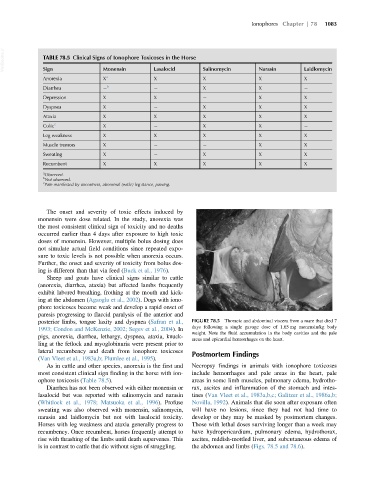Page 1151 - Veterinary Toxicology, Basic and Clinical Principles, 3rd Edition
P. 1151
Ionophores Chapter | 78 1083
VetBooks.ir TABLE 78.5 Clinical Signs of Ionophore Toxicoses in the Horse Salinomycin Narasin Laidlomycin
Monensin
Lasalocid
Sign
Anorexia X a X X X X
Diarrhea b X X
Depression X X X X
Dyspnea X X X X
Ataxia X X X X X
Colic c X X X
Leg weakness X X X X X
Muscle tremors X X X
Sweating X X X X
Recumbent X X X X X
a
Observed.
b
Not observed.
c
Pain manifested by uneasiness, abnormal (wide) leg stance, pawing.
The onset and severity of toxic effects induced by
monensin were dose related. In the study, anorexia was
the most consistent clinical sign of toxicity and no deaths
occurred earlier than 4 days after exposure to high toxic
doses of monensin. However, multiple bolus dosing does
not simulate actual field conditions since repeated expo-
sure to toxic levels is not possible when anorexia occurs.
Further, the onset and severity of toxicity from bolus dos-
ing is different than that via feed (Buck et al., 1976).
Sheep and goats have clinical signs similar to cattle
(anorexia, diarrhea, ataxia) but affected lambs frequently
exhibit labored breathing, frothing at the mouth and kick-
ing at the abdomen (Agaoglu et al., 2002). Dogs with iono-
phore toxicoses become weak and develop a rapid onset of
paresis progressing to flaccid paralysis of the anterior and
posterior limbs, tongue laxity and dyspnea (Safran et al., FIGURE 78.5 Thoracic and abdominal viscera from a mare that died 7
1993; Condon and McKenzie, 2002; Segev et al., 2004). In days following a single gavage dose of 1.65 mg monensin/kg body
weight. Note the fluid accumulation in the body cavities and the pale
pigs, anorexia, diarrhea, lethargy, dyspnea, ataxia, knuck-
areas and epicardial hemorrhages on the heart.
ling at the fetlock and myoglobinuria were present prior to
lateral recumbency and death from ionophore toxicoses Postmortem Findings
(Van Vleet et al., 1983a,b; Plumlee et al., 1995).
As in cattle and other species, anorexia is the first and Necropsy findings in animals with ionophore toxicoses
most consistent clinical sign finding in the horse with ion- include hemorrhages and pale areas in the heart, pale
ophore toxicosis (Table 78.5). areas in some limb muscles, pulmonary edema, hydrotho-
Diarrhea has not been observed with either monensin or rax, ascites and inflammation of the stomach and intes-
lasalocid but was reported with salinomycin and narasin tines (Van Vleet et al., 1983a,b,c; Galitzer et al., 1986a,b;
(Whitlock et al., 1978; Matsuoka et al., 1996). Profuse Novilla, 1992). Animals that die soon after exposure often
sweating was also observed with monensin, salinomycin, will have no lesions, since they had not had time to
narasin and laidlomycin but not with lasalocid toxicity. develop or they may be masked by postmortem changes.
Horses with leg weakness and ataxia generally progress to Those with lethal doses surviving longer than a week may
recumbency. Once recumbent, horses frequently attempt to have hydropericardium, pulmonary edema, hydrothorax,
rise with thrashing of the limbs until death supervenes. This ascites, reddish-mottled liver, and subcutaneous edema of
is in contrast to cattle that die without signs of struggling. the abdomen and limbs (Figs. 78.5 and 78.6).

